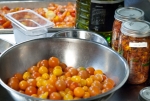Tomato, Tomahto: Preserving the Flavor

 Katherine Sacks
Katherine SacksRecipe
Photos
As we turn the corner into what promises to be another scorching summer (read: your patios and roof bars will be packed), tomato season is once more upon us. And while you ogle the nooks and crannies of the most obscure heirloom varieties, your customers will begin to demand tomatoes in everything—salads, soup, cocktails, the works. And long after tomatoes leave farmers market tables, a discerning chef can maximize flavor by preserving the fruit in olive oil, much like 2012 Atlanta Rising Star Robert Phalen does at his Holy Taco.
Although the Northern states still have a few weeks to wait until tomato fever really strikes, Phalen and his Southern counterparts are lucky—Georgia has an extended growing season. “Tomatoes have already come into season this year,” says Sous Chef Philip Meeker, who even had juicy tomatoes on hand last October. “Any sort of preservation technique helps you have these flavors later in the season,” he says. “You could stretch the season across the year this way.”
Although Meeker and Phalen occasionally use Roma tomatoes, when it comes to this olive oil technique, they generally favor local farmers' cherry tomatoes, both for their small size and sweeter flavor. Meeker enhances that sweetness further with a two-step process: instead of drying the tomatoes traditionally in the oven, he salts them overnight to bring out the natural sugars and then dries them in a dehydrator. “It takes out some of the bitterness and allows the sweetness of the tomatoes to shine through,” Meeker says.
After the tomatoes are dehydrated, Meeker places them in sterilized canning jars (he recommends running the jars through a commercial dishwashing machine and wearing gloves to reduce bacteria growth). For aromatics, he goes straightforward—just garlic and bay leaf—and then tops the jars with olive oil. Although it’s a simple technique, he offers a few guidelines: “The tomatoes take a lot of salt to develop their sweetness; don’t pack the tomatoes too firmly or you’ll squeeze out the little juice that is left; make sure the lid is dry so no rust development occurs.”
An additional perk from this process is the flavorful tomato water that results from the overnight salting. Meeker saves the liquid (straining it to remove seeds), and then evaporates it into tomato salt. “This salt will smell and have a little bit of the taste of the original tomatoes used in the brine,” he says. He combines the salt with anchovies, toasted pine nut, preserved Meyer lemons, and chives to create an earthy, zesty topping for Holy Taco’s sopes.
Preserving doesn’t have to be reserved for only off-season menu items. Even at the peak of produce, Meeker and Phalen pickle and preserve everything they can get their hands on, including radishes, turnips, carrots, and, of course, tomatoes . “Last year we did a butterbean dish as a side dish with both fresh and preserved tomatoes,” says Meeker. “It creates a really interesting contrast.”
Steps: Preserving Cherry Tomatoes
1. Salt the tomatoes, then place them in a perforated hotel pan and let them drain overnight refrigerated.
2. The next day, place the tomatoes in a dehydrator at 135°F; dehydrate until they are dry and taste like candy. They should be dry, but not unpleasant to chew on.
3. Process canning jars through a commercial dishwasher to reduce the likelihood of bacteria growth.
3. Wearing gloves, put the tomatoes into the canning jars, along with 3 to 4 pieces of garlic and 3 to 4 bay leaves per jar. Fill the jars with olive oil and store, refrigerated, for up to 3 months.
Related Links
- The Product: It’s Not Scraps, It’s Tuna Collar
- Fantasy Foodball: Championship Super Bowl Snacks
- The Atlanta Rising Stars Winners: Why They Shine
- Mo Bread, No Problems: Making the Original Chinese Hamburger Using Indian Naan
- Good Ol’ Southern Food (and Drink) in ATL
- Gnocchi Light as Air
- Jason Bond’s Red-Cooked Squash










